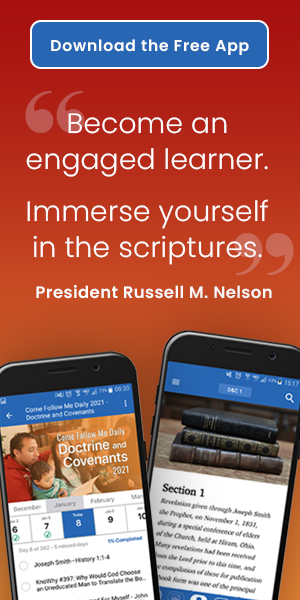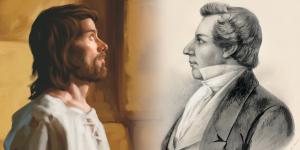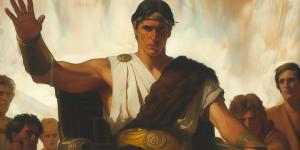You are here
What Can We Learn from 10 of the Best Chiasms in the Book of Mormon? Part 1

2 Nephi 25:26
Editor’s Note: This is part our on-going series on chiasmus, in celebration of the 50th anniversary of its discovery in the Book of Mormon. Be sure to check out our other KnoWhys on chiasmus and the Chiasmus Resources website for more information.
In the last fifty years, hundreds of chiasms have been potentially identified in the Book of Mormon.1 As John W. Welch noted in 1995, there are “varying degrees of chiasticity,” and while “many proposed chiasms are impressive and interesting; others appear to be contrived or unremarkable.”2 In other words, not all chiasms are created equal.
So to celebrate the discovery of chiasmus fifty years ago, we at Book of Mormon Central will present 10 of the most interesting chiasms in the Book of Mormon, over the next three weeks, starting with three today. Each one is interesting for different reasons. Some are impressive for their display of artistry and creativity, others are important for the doctrinal truths they help to teach, clarify, or emphasize, while yet others are significant because of ancient Hebrew or Mayan connections.
Readers are invited to evaluate these chiasms themselves utilizing the criteria discussed previously.3
Mosiah 5:10–12
The Know
This was the first chiastic passage ever discovered in the Book of Mormon five decades ago, so it only seems fitting to begin with it here.4 Statistically, Mosiah 5:10–12 is one of the four strongest chiasms in the Book of Mormon.5 It is a tightly structured, well-balanced chiasm, found toward the end of King Benjamin’s speech, and is the central piece to a larger chiastic structure in the final section of that famous discourse,6 thus “emphasiz[ing] the central importance of taking upon oneself the name of Christ.”7
The Why
This chiasm incorporates terms used nowhere else in the Book of Mormon: left hand of God and blotted out.8 The use of such rare terms twice in such a well-balanced passage adds to the deliberateness of the chiastic pattern, and thus it “simply strains reason to imagine that such a structure … occurred accidentally.”9 It is “precise, extensive, and meaningful,”10 as it powerfully builds to its climax, intensifying King Benjamin’s warning against transgression.11 All these features make this passage arguably “one of the great chiastic writings of all time.”12
Chiastic Structure of Mosiah 5:10–12 |
||||||
|
A |
And now it shall come to pass, that whosoever shall not take upon him the name of Christ |
|||||
|
|
B |
must be called by some other name; |
||||
|
|
|
C |
therefore, he findeth himself on the left hand of God. |
|||
|
|
|
|
D |
And I would that ye should remember also, that this is the name |
||
|
|
|
|
|
E |
that I said I should give unto you that never should be blotted out, |
|
|
|
|
|
|
|
F |
except it be through transgression; |
|
|
|
|
|
|
F |
therefore, take heed that ye do not transgress, |
|
|
|
|
|
E |
that the name be not blotted out of your hearts. |
|
|
|
|
|
D |
I say unto you, I would that ye should remember to retain the name |
||
|
|
|
C |
written always in your hearts, that ye are not found on the left hand of God, |
|||
|
|
B |
but that ye hear and know the voice by which ye shall be called, |
||||
|
A |
and also, the name by which he shall call you. |
|||||
2 Nephi 1:5–7
The Know
Current editions of the Book of Mormon actually make this chiasm harder to detect,13 because in 2 Nephi 1:5 it says “the Lord hath covenanted this land unto me.” This wording has been traced back to the printer’s manuscript,14 but the original manuscript has consecrated instead of covenanted.15 This correction makes a stronger parallel with the statement “this land is consecrated” in 2 Nephi 1:7, and thus makes the chiasm clearer.
The Why
This example illustrates why it is important to have the most accurate version of the text when looking for chiasms and other word patterns in the Book of Mormon. In addition, Royal Skousen has used chiastic patterns to help determine which variant of the original text is most likely correct, or even when a conjectural emendation might be necessary.16 Thus, chiasmus is more than just a neat curiosity—it is a literary and textual tool which can aid in determining the most accurate version of the text.
Chiastic Structure of 2 Nephi 1:5–717 |
|||||
|
A |
But, said he, notwithstanding our afflictions, |
||||
|
|
B |
we have obtained a land of promise, a land which is choice above all other lands, a land which the Lord God hath covenanted with me should be a land for the inheritance of my seed. |
|||
|
|
|
C |
Yea, the Lord hath consecrated this land unto me, and to my children forever, |
||
|
|
|
|
D |
and also all those who should be led out of other countries by the hand of the Lord. |
|
|
|
|
|
|
E |
Wherefore, I, Lehi, prophesy according to the workings of the Spirit which is in me, |
|
|
|
|
D |
that there shall none come into this land save they should be brought by the hand of the Lord. |
|
|
|
|
C |
Wherefore, this land is consecrated unto him whom he shall bring. |
||
|
|
B |
And if it so be that they shall serve him according to the commandments which he hath given, it shall be a land of liberty unto them, |
|||
|
A |
wherefore, they shall never be brought down into captivity. |
||||
2 Nephi 25:24–27
The Know
This passage forms a “messianic hymn” within Nephi’s commentary on Isaiah,18 and is statistically a very strong chiasm, with a high likelihood (99.98%) of being intentional.19 Two somewhat different chiastic patterns have been proposed for this passage,20 both of which are multilayered and centered on the fact that Nephite leaders talked, rejoiced, preached, prophesied, and wrote about Christ for the benefit of their rising generation.
The Why
As part of a larger effort by Nephi to use chiasmus and other poetic forms to testify of Christ,21 this chiasm forms the culmination of Nephi’s teachings on Christ and the law. Every level of the chiasm mentions the law except the central elements—which emphasize Christ and the importance of testifying of Him to future generations.22 This structure makes the law into a type and shadow that literally points to Christ at the center.23 Thus, the overall structure is “consciously designed to convey … that salvation belongs not to the law as such, but to the Lord.”24
Chiastic Structure of 2 Nephi 25:24–27 |
||||||||||||
Proposal 1 |
Proposal 2 |
|||||||||||
|
A |
a |
And, notwithstanding we believe in Christ, we keep the law of Moses |
A |
a |
And, notwithstanding we believe in Christ, |
|||||||
|
|
|
b |
and look forward with steadfastness unto Christ, |
|
|
b |
we keep the law of Moses |
|||||
|
|
|
|
c |
until the law shall be fulfilled |
|
B |
a |
and look forward with steadfastness unto Christ, |
||||
|
|
|
|
|
d |
For, for this end was the law given, |
|
|
|
b |
until the law shall be fulfilled |
||
|
|
B |
wherefore the law hath become dead unto us, and we are made alive in Christ because of our faith; yet we keep the law because of the commandments. |
|
|
C |
For, for this end was the law given, |
||||||
|
|
|
|
D |
a |
wherefore the law hath become dead unto us |
|||||||
|
|
|
|
|
|
b |
and we are made alive in Christ because of our faith; |
||||||
|
yet we keep the law because of the commandments. |
||||||||||||
|
|
|
C |
And we talk of Christ, we rejoice in Christ, we preach of Christ, we prophesy of Christ |
|
|
|
|
E |
And we talk of Christ, we rejoice in Christ, we preach of Christ, we prophesy of Christ |
|||
|
|
|
C |
and we write according to our prophecies, that our children may know to what source they may look for a remission of their sins. |
|
|
|
|
E |
and we write according to our prophecies, that our children may know to what source they may look for a remission of their sins. |
|||
|
|
B |
Wherefore, we speak concerning the law that our children may know the deadness of the law; and they, by knowing the deadness of the law, may look forward unto that life which is in Christ |
Wherefore, we speak concerning the law that our children may know |
|||||||||
|
|
|
|
D |
the deadness of the law; |
||||||||
|
a |
and they, by knowing the deadness of the law, |
|||||||||||
|
|
b |
may look forward unto that life which is in Christ |
||||||||||
|
A |
|
|
|
d |
and know for what end the law was given. |
|
|
C |
and know for what end the law was given. |
|||
|
|
|
|
c |
And after the law is fulfilled |
|
B |
And after the law is fulfilled in Christ, |
|||||
|
|
|
b |
in Christ, that they need not harden their hearts against him |
A |
that they need not harden their hearts against him when the law ought to be done away. |
|||||||
|
|
a |
when the law ought to be done away. |
||||||||||
- 1. “Chiasmus Index: Book of Mormon,” at Chiasmus Resources; Donald W. Parry, Poetic Parallelisms in the Book of Mormon: The Complete Text Reformatted (Provo, UT: Neal A. Maxwell Institute for Religious Scholarship, 2007).
- 2. John W. Welch, “Criteria for Identifying and Evaluating the Presence of Chiasmus,” Journal of Book of Mormon Studies 4, no. 2 (1995): 14, 13, capitalization altered.
- 3. See Book of Mormon Central, “What Counts as Chiasmus? (1 Nephi 19:7),” KnoWhy 337 (July 10, 2017).
- 4. See John W. Welch, “The Discovery of Chiasmus in the Book of Mormon: Forty Years Later,” Journal of Book of Mormon Studies 16, no. 2 (2007): 79.
- 5. Boyd F. Edwards and W. Farrell Edwards, “Does Chiasmus Appear in the Book of Mormon by Chance?” BYU Studies 43, no. 2 (2004): 118–120.
- 6. See John W. Welch, “Parallelism and Chiasmus in Benjamin’s Speech,” in King Benjamin’s Speech: “That Ye May Learn Wisdom,” ed. John W. Welch and Stephen D. Ricks (Provo, UT: FARMS, 1998), 369–373.
- 7. John W. Welch and J. Gregory Welch, Charting the Book of Mormon: Visual Aids for Personal Study (Provo, UT: FARMS, 1999), chart 131.
- 8. Welch, “Parallelism and Chiasmus in Benjamin’s Speech,” 373.
- 9. John W. Welch, “Chiasmus in the Book of Mormon,” in Chiasmus in Antiquity: Structures, Analyses, Exegesis, ed. John W. Welch (Hildesheim, GER: Gerstenberg Verlag, 1981; reprint Provo, UT: Research Press, 1999), 205.
- 10. Welch, “Chiasmus in the Book of Mormon” (1981), 205.
- 11. Welch, “Parallelism and Chiasmus in Benjamin’s Speech,” 373.
- 12. Welch, “Chiasmus in the Book of Mormon,” 205.
- 13. This chiasm was proposed by Robert F. Smith, personal communication with Book of Mormon Central Staff, May 30, 2017.
- 14. See Royal Skousen, ed., The Printer’s Manuscript of the Book of Mormon: Typographical Facsimiles of the Entire Text in Two Parts, The Book of Mormon Critical Text Project, Volume 2 (Provo, UT: FARMS, 2001), 144; Royal Skousen and Robin Scott Jensen, eds., Printer’s Manuscript of the Book of Mormon 1 Nephi–Alma 35, Revelations and Translations Volume 3, Part 1, Joseph Smith Papers (Salt Lake City, UT: Church Historian’s Press, 2015), 113.
- 15. See Royal Skousen, ed., The Original Manuscript of the Book of Mormon: Typographical Facsimile of the Extent Text, The Book of Mormon Critical Text Project, Volume 1 (Provo, UT: FARMS, 2001), 165. For a discussion of the change, see Royal Skousen, Analysis of Textual Variants of the Book of Mormon, Part One: 1 Nephi 1–2 Nephi 11, 2nd edition, The Book of Mormon Critical Text Project, Volume 4 (Provo, UT: FARMS and BYU Studies, 2017), 496–497.
- 16. Royal Skousen, Analysis of Textual Variants of the Book of Mormon, Part Three: Mosiah 14–Alma 17, 2nd edition, The Book of Mormon Critical Text Project, Volume 4 (Provo, UT: FARMS and BYU Studies, 2017), 1608–1609; Royal Skousen, “The Systematic Text of the Book of Mormon,” in Uncovering the Original Text of the Book of Mormon: History and Findings of the Critical Text Project, ed. M. Gerald Bradford and Allison V. P. Coutts (Provo, UT: FARMS, 2002), 63.
- 17. The text here follows the wording in Royal Skousen, ed., The Book of Mormon: The Earliest Text (New Haven, CT: Yale University Press, 2009), 73.
- 18. John W. Welch, “Chiasmus in the Book of Mormon,” in Chiasmus in Antiquity: Structures, Analyses, Exegesis, ed. John W. Welch (Hildesheim, GER: Gerstenberg Verlag, 1981; reprint Provo, UT: Research Press, 1999), 202.
- 19. Dennis Newton, “Nephi’s Use of Inverted Parallels,” Interpreter: A Journal of Mormon Scripture 22 (2016): 87–88.
- 20. For one proposal, see Welch, “Chiasmus in the Book of Mormon” (1981), 202; John W. Welch, “Chiasmus in the Book of Mormon,” in Book of Mormon Authorship: New Light on Ancient Origins, ed. Noel B. Reynolds (Provo, UT: Religious Studies Center, Brigham Young University, 1982; reprint FARMS, 1996), 47. For the second proposal, see David E. Sloan, “Nephi’s Convincing of Christ through Chiasmus: Plain and Precious Persuading from a Prophet of God,” Journal of Book of Mormon Studies 6, no. 2 (1997): 91; Donald W. Parry, Poetic Parallelisms in the Book of Mormon: The Complete Text Reformatted (Provo, UT: Neal A. Maxwell Institute for Religious Scholarship, 2007), 112. Newton, “Nephi’s Use of Inverted Parallels,” 96 introduces a third chiastic arrangement of this passage.
- 21. Sloan, “Nephi’s Convincing of Christ through Chiasmus,” 67–97, esp. 90–93.
- 22. See Newton, “Nephi’s Use of Inverted Parallels,” 96–97.
- 23. See Sloan, “Nephi’s Convincing of Christ through Chiasmus,” 90–93.
- 24. Welch, “Chiasmus in the Book of Mormon” (1981), 202.
KnoWhy Citation
Related KnoWhys
Subscribe
Get the latest updates on Book of Mormon topics and research for free





